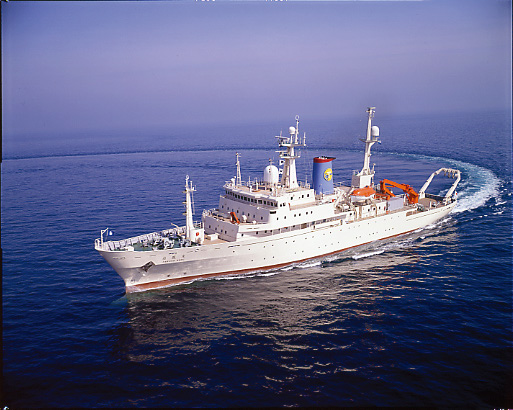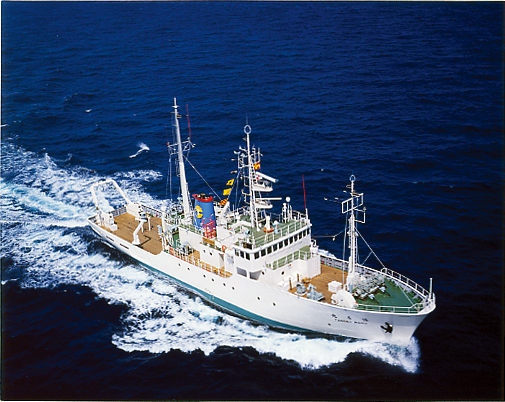CTD data (mainly temperature and salinity) acquired by R/V Hakuho-maru and R/V Tansei-maru can be downloaded.
Research Vessel:
| |
Hakuho maru |
Tansei maru |
| |
 |
 |
This database compiles microbial (prokaryotic cells and viruses) abundance and production data collected in the oceanic water columns during the Hakuho-maru cruises. Associated ancillary information (CTD and nutrient data) is also provided with the permission of cruise directors and/or the PI’s responsible for the data collection and management. For the ancillary information, see the disclaimer of the “Hakuho maru and Tansei maru Database” https://cesd.aori.u-tokyo.ac.jp/oceandb/disclaimer_JP.html. When a part or all of the contents of this site are referred to, please cite as "FddMAP".
NICAM is a Nonhydrostatic ICosahedral Atmospheric Model (NICAM),
used as a Global Cloud Resolving Model (GCRM).
A 3.5km-mesh global simulation is already performed using the Earth Simulator.
See also NICAM official page nicam.jp
NICAM is first developed by H.Tomita (FRCGC, JAMSTEC) and M.Satoh,
and is now under development in cooperation with CCSR and JAMSTEC.
CloudSat was launched together with the CALIPSO (Cloud-Aerosol Lidar and Infrared Pathfinder Satellite Observations) satellite aboard a Delta II rocket on 28 April 2006. In a series of maneuvers, CloudSat and CALIPSO joined three satellites already in orbit ( Aqua, PARASOL, and Aura) to form a constellation of satellites known as the A-Train on 1 June 2006.
CloudSat uses a millimeter-wavelength radar to measure the altitude and properties of clouds. Slicing a vertical cross-section of the atmosphere, the satellite's cloud profiling radar measures meteorological data including cloud-layer thickness, cloud top and base altitudes, cloud optical properties, and cloud water and ice content.
Because clouds have a large impact on the Earth's radiation budget, even small changes in cloud abundance or distribution could potentially alter the climate more than the anticipated changes in greenhouse gases, anthropogenic aerosols, or other factors associated with global change.
These considerations lead scientists to believe that the main uncertainties in climate model simulations are due to the difficulties in adequately representing clouds and their radiative properties.
On this Website, the vertical distribution of reflectivity for each individual track observed by Cloudsat is shown. The CloudSat Data Processing Center provides these Cloudsat data to us.
The Cloud-Aerosol Lidar and Infrared Pathfinder Satellite Observations (CALIPSO) satellite follows the CloudSat satellite within 15 seconds along the same orbit. CALIPSO carries the CALIOP lidar which emits linear polarized pulses at the two wavelengths (532 nm and 1064 nm). Its receiver measures total backscattered intensity at 1064nm, and the two orthogonal polarized components at 532nm. CALIOP can detect aerosols and thin clouds which are not observed by the CloudSat radar.
The co-located observations by CloudSat and CALIPSO are useful for studying the vertical profiles of clouds and aerosols and many researchers use these data.
On this Website, attenuated backscatter profiles at 532nm observed by CALIPSO are shown. The color of the orbit represents the Profile Time UTC. The Atmospheric Science Data Center provides these CALIPSO data to us.
We provide an user friendly system of scientific numerical computing packages developed in our studies (please visit 'Contributors' page).
The name of our system ,'OpenCLASTR', is an acronym meaning Open Clustered Libraries for Atmospheric Science and Transfer of Radiation. Its name comes from "Open Cluster" , an astronomical object. Mathematics libraries, a radiative transfer library, dynamics libraries for atmospheric sciences,and retrieval libraries for remote-sensing data, are combined in OpenCLASTR, like a cluster of stars twinkling in the universe.
Because the OpenCLASTR is operated voluntarily without any profits, we wish all users of OpenCLASTR to respect the following policy.
Libraries included in this system are provided to users with the understanding that they will be used only for non-profit scientific or educational purposes, the origin of the data, programs, parameters, are always acknowledged, and the users assume complete responsibility for any direct and indirect damages due to use of these libraries.
ー Genetic Research
- MitoFish is a comprehensive and standardized fish mitochondrial genome database.
MitoFish has four main functions, i.e., taxonomy/species search, sequence similarity search, data batch download, and fish mitogenome annotation. The menu bar on the right side allows users to access these functions, and the former two functions are also directly available from the boxes on the top page.
-


